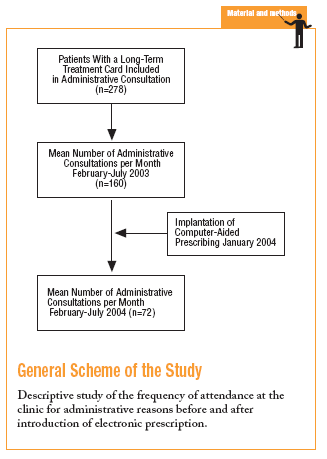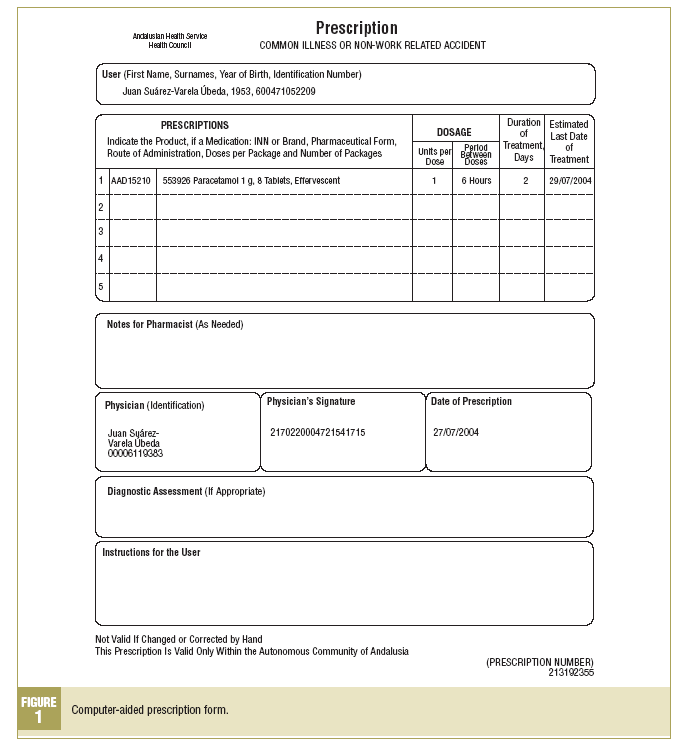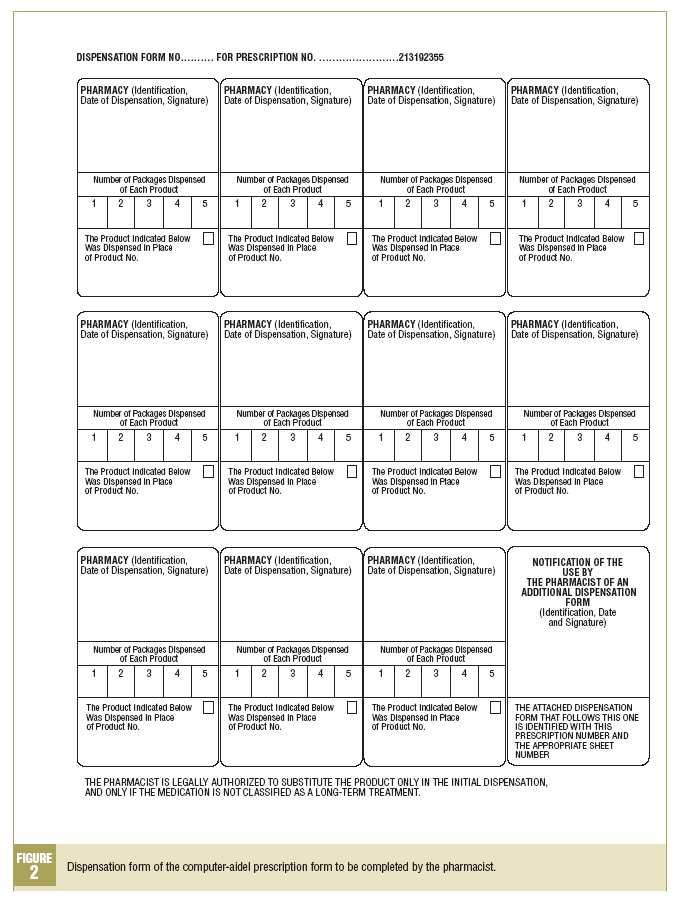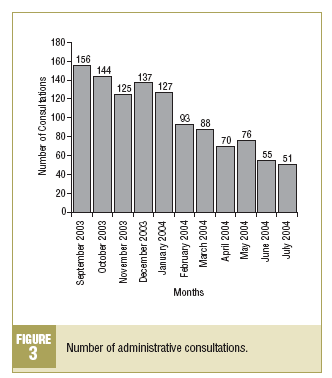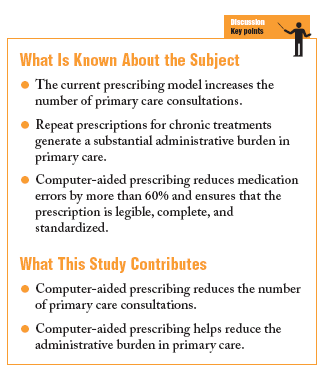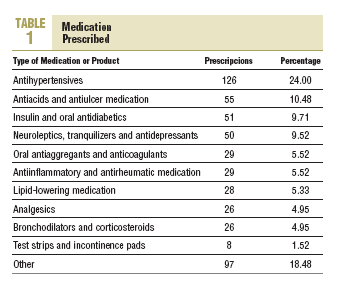Introduction
Prescription renewal for long-term treatments is one of the main reasons for consulting in primary care.1,2 Against a background of the already large patient loads borne by primary care services, this motive has led to further increases in the numbers of visits to renew prescriptions for long-term treatment. Since reforms were undertaken in the public health system in Spain to improve primary care, several different models have been tested in an attempt to move these administrative consultations out of primary care centers, with the aim of improving demand management. Long-term treatment cards3,4 and other more recent strategies such as computerizing repeat prescriptions with authorized medication cards5,6 have been tried. Computer-assisted prescribing, although used thus far only in limited settings, has led to substantial progress in reducing medication errors by more than 60%, simply by ensuring that prescriptions are legible, complete and presented in a standardized format.7,8
However, these solutions share the same problem: a prescription is a public document with legal implications for the physician who signs it and for the pharmacist who fills it.9 The legal requirement for a physician's signature obviates the possibility of delegating the function of prescribing. Moreover, follow-up vigilance and adjustments or changes in the prescribed medication along with supervision of adherence to treatment are not well supported by these models once the number of patients involved becomes large. Computer-aided prescribing offers a way around these problems by providing prescriptions valid for 6 months or 1 year, until the date of the next follow-up visit with the physician.
The present study was designed to determine the extent to which the introduction of a system for computer-aided prescribing helped reduce the administrative burden at primary care centers and thus freed resources for other heath care actions.
Patients and Methods
The study was done at the Torreblanca Health Center (province of Seville, southern Spain), the first center in the region of Andalusia where computer-aided prescribing was piloted. This center serves an estimated population of 22 000 inhabitants of low sociocultural level, and the population contains large groups of marginalized persons living in two shanty towns. The population is relatively young, with persons younger than 14 years comprising almost 20% of the population, and the prevalence of toxic substance addiction and chronic diseases and disorders (e.g., diabetes, hypertension, mental illness, etc) is high. In August 2003 the Citizen's Digital Medical Record computerized medical records system was installed (under the project name Diraya) as a replacement for the previous computerized system (known as TASS). Computer-aided prescribing was included in the new system as part of the digital medical record.
The Diraya system allows health care professionals access to a database for the region of Andalusia maintained in Seville (where the administrative offices of the regional health system are located). The database contains information on all users of the public health care system in the region. The key for accessing computer-aided prescription operations is the patient's health card, a document issued to each individual user and bearing the user's personal code number. This number serves to confirm that the patient is a legitimate user of the public health system and indicates the type of pharmaceutical service the user has access to.
When the physician issues a computer-aided prescription the information is recorded in the patient´s dispensation module along with the patient's current "pharmaceutical credit," which indicates the full treatment prescribed by the family physician.
All prescriptions issued at that time are printed out on the revised official prescription form (Figure 1). The physician indicates dosage and duration of treatment, and can add further instructions for the patient as needed. The prescription form is kept by the patient and is presented each time the prescription is filled by the pharmacist until it expires (after a maximum period of 1 year). The pharmacist notes the required dispensation information on the second page of the form each time a prescription is filled (Figure 2).
Prescriptions can be filled at any pharmacy in the basic health zone where the patient resides that is operated by a pharmacist accredited with the regional health service. Patients must show their public health system ID card to the pharmacist, who uses the number on the card to gain access on line to the central dispensation module, where the medication prescribed and patient's type of coverage for the cost of prescriptions (employed, retired, other) is shown.
The physician can at any time modify or cancel any register in the patient's central dispensation module as needed; the patient is informed of such changes. The physician can also check the number of times the medications have been dispensed to the patient and thus track adherence to treatment.
When necessary for health-related reasons the pharmacist can withhold dispensation of specific products as a precautionary measure and inform the physician of this decision by completing a specially-designed on-line report form.
A pilot program has been in effect since 29 October 2003 at our health center to test computer-aided prescribing in the region of Andalusia (Receta XXI program) in actual patients. We took advantage of the fact that some physicians were already using a computer-aided system for repeat prescriptions provided through an administrative consultation to compare the number of visits for this motive during the period from February to July 2003 (previous system) with the number of visits for repeat prescriptions under the pilot program (new system) for the same period in 2004. Administrative consultations at the health center were scheduled weekly on Thursdays between 12.00 and 14.00 hours.
In this study we included all patients who were receiving long-term treatment, who had a long-term treatment card, who attended administrative consultations to renew their prescriptions, and who were included in the list of patients assigned to physicians who participated in the computer-aided prescription program. The number of weekly administrative consultations during 2003 was recorded from local TASS databases, and the number of weekly administrative consultations during 2004 was recorded from the central Diraya database. Data for these 2 periods were compared and the resulting descriptive statistics are reported below.
Results
Figure 3 shows the number of administrative visits to the health center recorded under the Diraya system from September 2003 to July 2004. Numbers are given for the start of computer-aided prescribing in clinical consultations for patients with chronic diseases or disorders for which care is offered at the center (a factor that led to a slight decrease in the number of administrative visits) and for the period when computer-aided prescribing was started in administrative consultations. The use of computer-aided prescribing for administrative consultations led to a substantial decrease in the number of visits starting in February 2004, and the decrease became steadily larger thereafter. In July 2004 the mean number of monthly visits for administrative consultation was 51, which reflected a 55% decrease in the mean number of monthly consultations from February-July 2003 to February-July 2004 (Figure 4). If we consider that approximately 3% to 5% of all administrative consultations were to pick up medical certificates of temporary incapacity for work and that these figures tend to remain stable, the decrease in the number of visits to renew prescriptions was greater than 60%.
The mean percentage of all prescriptions that were issued with the computer-aided system during the period from January to July 2004 was 13.24%: this figure represents a steady increase from 8.03% in January to 25.6% in June. Of these prescriptions, 68.4% were issued to pensioners and 31.16 to actively employed persons. The total number of packages dispensed was 1480, acquired by a total of 138 patients during this 6-month period. The packages dispensed comprised 528 valid prescriptions (i.e., 528 different products). Thus the mean number of different products consumed by each patient with a chronic disease or disorder was 3.83.
Of the total number of 616 prescriptions, 88 were canceled (14.29%) for the following reasons: medical order to suspend treatment in 51.14% of the cases; dispensation requested after the final date of treatment in 48.86% of the cases. The mean number of visits to pharmacies per month was 1.61, and the mean numbers of medications prescribed per therapeutic group are shown in Table.
Discussion
The introduction of computer-aided prescribing on 29 October 2003 during clinical consultations for patients receiving long-term care through the health center initially led to a small decrease in administrative consultations (Figure 3), as some patients who needed more than one medication were also followed in the latter. The mean number of visits per month decreased to 130 patients. After computer-aided prescribing was introduced on 15 January for all patients with chronic conditions who were seen in administrative consultations, the mean number of visits per month decreased rapidly and remained low. The mean number of visits per month fell to 72, and in July the mean number of visits per month was only 51 (Figure 3). This sustained decrease in the number of visits will make it possible to suspend the weekly administrative consultations in the short term and thus gain 2 hours per week for clinical consultations. Although this may appear to be a small gain, the long-term nature of care that characterizes primary care services means that we were able to see 4 patients with diabetes or benign prostatic hypertrophy each week at a rate of 30 minutes per consultation, so that by the end of the year it was foreseen that all patients served by our health center who were eligible for long-term care programs could be included in the appropriate program.
For the period up to March 2004, the most frequent cause for cancellation of a computer-aided prescription was request for dispensation past the estimated last date of
treatment. The grace period was initially set at 5 days before to 10 days after the estimated last day of treatment. As a result of this finding the end of the dispensation grace period was extended from 10 days to 2 months after the estimated end of treatment (the 5-day period before the end of treatment remained unchanged), as cancellation of one medication implied the cancellation of all other medications included in the same prescription (maximum of 5 per prescription). It was often the case that some medications in the prescription, such as analgesics or bronchodilators, are used as needed and the last day of treatment was sometimes later than that indicated in the prescription. Since then cancellations for this reason have been very rare.
The most frequent cause of medical order to suspend treatment was cancellation of the prescription during demonstrations of the system to visiting groups of physicians and pharmacists from other regions of Spain (Catalunya and Navarre) and other countries (Sweden, France, and Argentina).
We consider the mean number of visits per month to pharmacies (1.61) to be too high. This result may be related with the fact that the number of packages of each product that can be acquired per visit is limited to one, so that users need to return to the pharmacy when the product with the smallest number of doses per package runs out. This problem demotivates some users, since under the previous system more than one package of the medication likely to run out soonest could be acquired at once; the number of packages dispensed was calculated on the basis of the medication that would last the longest. To avoid this problem a similar approach to multiple dispensations is being considered for the Receta XXI program.
The most heavily used therapeutic groups were those for the most prevalent chronic diseases (Table 1). The low rates of prescription for test strips and incontinence pads under this system reflected the fact that these products require administrative authorization, and there were initially problems with electronic authorization in the new system. To date a satisfactory mechanism has yet to be developed for computer-aided prescription renewal, necessitating the issue of a new prescription when the previous one has been dispensed in its entirety.
A search of the literature identified only one article10 that analyzed the characteristics and safety of prescription issued by family physicians with computer-aided systems; however, this study did not involve actual patients but was based on dummy patient records.
At a seminar organized by the European Health Telematics Association in Amsterdam in June 2004, specific strategies for computer-aided prescribing were examined11 and the extent of implementation in different countries in Europe was compared. The countries where most progress has been made were Denmark, with 70% of all prescriptions issued electronically, and Sweden, where this figure was 27%. The situation in England was similar to that in Spain, as both countries have piloted systems for computer-aided prescribing but have not yet implemented this tool on a wide scale. The rest of the countries in Europe are still in the very early stages of development of similar systems.
Because the available data are preliminary, we have evaluated here only the improvements attained with computer-aided prescribing with regard to a problem particular to the primary care setting: the patients' need to renew prescriptions for long-term treatments and the resulting excess demands on the family physician's time. Aside from this problem, however, the current prescription and dispensation model has other failings such as dispensation errors, dosage errors, heavy administrative burden to ensure correct payment at the pharmacy, and difficulties in generating a database of medications that might be used to analyze prescriptions. In developed countries one person dies every hour because of a medication-related problem (error, contraindication, self-underdosage, interactions or side effects).12 A computer-aided prescribing system would help reduce these problems by making it possible to issue alerts for contraindications and interactions, and by improving the tracking and monitoring of treatments.10
For these reasons the introduction of computer-aided prescribing should be a priority action in public health systems, and should become an important criterion for improving the quality of health care.







